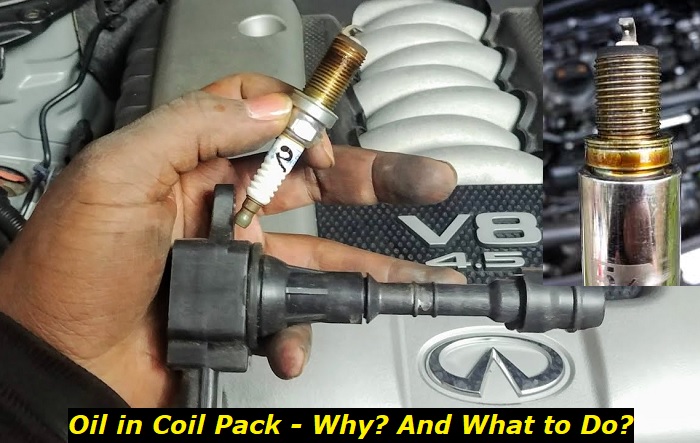You would be tempted to think that every engine component requires some sort of lubrication, right? Well... not every component. We know that most people out there have this preconception about engines being oily and dirty. While this might have been the case a long time ago, when tolerances and quality standards weren't even close to what they are these days, it is no longer applicable.
Oil leaks highlights
- Level of urgency:medium
- Average mileage:over 50,000 miles
- Repair cost:$200 - $1,800
- DIY repair:only in some cases
- Commonreasons:head gasket, other gaskets, seals, fasteners
- If ignored:low engine oil level, contamination of units under the hood, engine damage
- How to solve:locate the leak and repair the system that is leaking

What is a coil pack and what does it do?
Before talking about coil packs that are soaked in oil, let's first understand what they are and what they do, shall we? Basically, coil packs are a collection of ignition coils that transform electricity that is coming from the vehicle's battery into high-intensity electric current, which is used to generate the spark necessary to burn fuel.
Coil packs and spark plugs are two different and separate components, which is why it's important to know the difference between them. The spark plug produces the spark and the coil pack is the electrical component that powers it.
Spark plugs and coil packs are usually located on the top of the cylinder head, in such a way that the spark plug is mounted on top of the combustion chamber. As you might know, in the cylinder head there are many components that require good lubrication at all times, which is why oil is always very close to where the spark plugs and coil packs are located.
Why is there oil in the coil pack?
Now that you have a basic idea of what the purpose of a coil pack is, let's talk about why you might notice that they are soaked in oil. Here are a few causes:
1) Leaking valve cover gasket
Valve covers require gaskets in order to keep all the oil from leaking and whenever these gaskets go bad, you will almost certainly notice oil leaks on the sides of your engine. Sometimes, oil ends up leaking on the exhaust manifold, which will not only cause a strong smell of burning but can also increase the risk of fire.
However, the valve cover gaskets also cover the spark plug wells, which is where the coil packs and spark plugs are located. In certain cases, they can give up before the actual gasket of the valve cover, in which case, you will not notice any visible oil leak on the sides of the engine.
In order to check the spark plug well gaskets, simply remove one ignition coil at a time and check if the spark plug well is dry. If not, you know where to start.
2) Damaged valve cover
Sometimes, even using brand new high-quality gaskets will still cause oil leaks that are coming from the valve cover. As strange as it may seem, the valve cover itself might be the issue in this case. With age, and because of exposure to heat, they can become damaged, especially if they are made out of plastic. If you know that the valve cover gasket has been installed properly, yet you still have a leak, you might want to take into consideration trying a new valve cover.
3) Worn valve guide seals
If we take a closer look at the cylinder head, we're going to notice that the intake and exhaust valves are centered by a set of guides. They are used secure the valves in place while the engine is working. Each one of them contains a special seal that prevents oil from getting into the combustion chamber. Should they fail, not only will you notice oil leaking into the combustion chamber, but also onto the spark plugs or into the coil pack itself.
4) Worn ignition coil O-rings
You might have noticed that each ignition coil features a tube that covers the spark plug. These components have O-rings sometimes and if they fail, you will notice something that happens pretty much always when an O-ring fails, which is an oil leak. Also, since these tubes are usually made out of plastic or rubber, you should keep in mind that these are two materials that get very brittle with age or when exposed to heat, which is why you might want to consider replacing them every once in a while.
5) Worn piston rings
When the piston rings have gone bad, oil soaking the coil pack will be just one of your problems. Whenever this happens, the fuel consumption will decrease and so will the engine power. Did we also mention that oil consumption will greatly increase?
6) Cracked/damaged pistons
Just like in the case of piston rings, cracked or damaged pistons will not only cause the engine to run very poorly indeed, but they could also cause oil to end up in the spark plug wells and therefore soak the coil packs in oil.
What does this lead to?
Now that you know what might cause this issue, let's talk about how it will affect the way your vehicle is running. Here are some of the things you might notice:
- Blue-colored exhaust smoke
Have you noticed that your car's exhaust gases are suddenly visible? Is the smoke's color bluish? If that's the case, you should know that blue-colored smoke indicates that the engine is burning oil. Even though this sometimes indicates more serious issues, such as bad piston rings, you should probably start by checking if there's oil on the coil packs.
- Engine misfire
A spark plug or a coil pack that is covered in oil will never be able to produce a spark good enough to efficiently burn fuel, which is why the engine might start misfiring.
- High fuel consumption
You should probably know that whenever the efficiency of the combustion is even slightly affected in any way, you will notice this in your vehicle's fuel economy, which will get significantly worse.
- Backfiring
In certain cases, the engine might even start backfiring because of bad combustion, which will further affect the way your vehicle drives.
How to fix the problem?
Fixing this problem should begin with performing a visual inspection of the valve cover gasket, coil packs, and spark plugs. You could even try performing a diagnostic in order to see on which cylinders you have misfired, which might help you locate the exact cause of your issue.
Replacing valve cover gaskets, spark plugs, and coil packs is something that can be done by DIY enthusiasts at home and it shouldn't be something too difficult to do with a basic set of tools while following the instructions from a service manual specific to the make and model of the vehicle you're working on. The coil packs might be slightly more expensive, but they are usually affordable enough to replace, if faulty.
However, if the issue is related to the piston rings or to the pistons themselves, things can get very expensive. You see, whenever you have piston-related issues, the entire engine needs to be taken apart. There is no way to replace piston rings or pistons without disassembling the engine. While the parts themselves aren't necessarily expensive, there are many "while in there" items, such as gaskets, O-rings, and rod bearings, which will eventually add up in the final cost of the engine rebuild.
What will be really expensive would be the labor. If you aren't an experienced mechanic and you do not have the necessary tools for this job, we would definitely not recommend you to try this at home. No matter how expensive labor is, if you try to do this and you make one small mistake, you might end up destroying your engine altogether, which will result in a much bigger repair bill.
How to avoid issues in the future?
Simply visually check the gaskets, spark plugs, and coil packs from time to time, and only use high-quality oils that are recommended by your vehicle's manufacturer. Apart from that, there isn't much else you can do to avoid such issues.
Should you drive like this?
While you can drive your car like this, we would not recommend you to do so. By driving the car in this state, you could make more irreparable damage, which you might regret later.
Final thoughts
Even though it's vital that the engine has good lubrication at all times, there are certain components that should never see any oil. Remember that $2 leaking O-ring you keep ignoring, thinking that it can't cause too much harm? You might want to seriously think about replacing it now.
About the authors
The CarAraC research team is composed of seasoned auto mechanics and automotive industry professionals, including individuals with advanced degrees and certifications in their field. Our team members boast prestigious credentials, reflecting their extensive knowledge and skills. These qualifications include: IMI: Institute of the Motor Industry, ASE-Certified Master Automobile Technicians; Coventry University, Graduate of MA in Automotive Journalism; Politecnico di Torino, Italy, MS Automotive Engineering; Ss. Cyril and Methodius University in Skopje, Mechanical University in Skopje; TOC Automotive College; DHA Suffa University, Department of Mechanical Engineering






Add comment